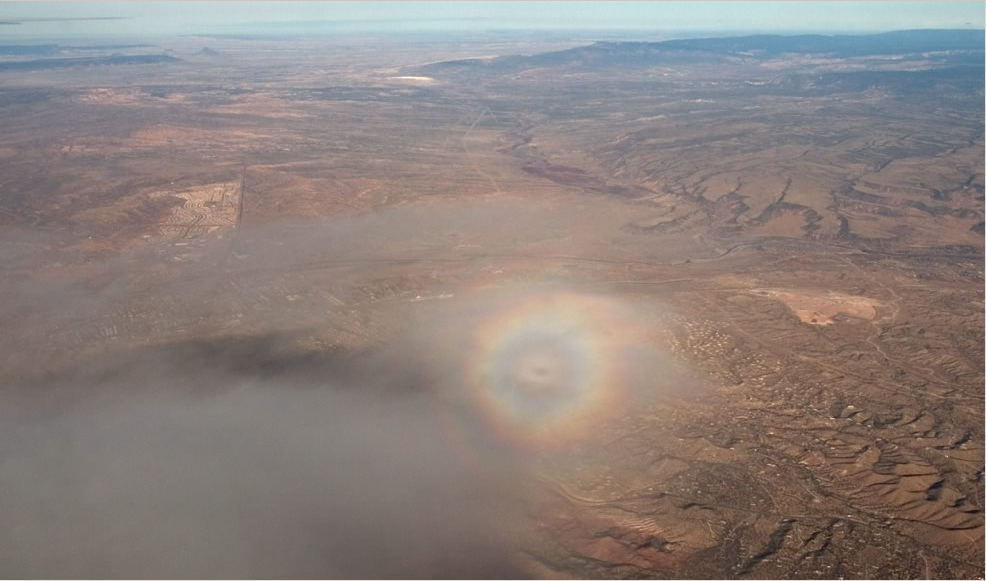Glory over New Mexico
Glory over New Mexico: A Captivating Atmospheric Phenomenon
New Mexico, with its diverse and captivating landscapes, is not only known for its stunning sunsets and expansive deserts but also for its unique atmospheric phenomena. One such phenomenon that has mesmerized both locals and visitors alike is the "Glory." A glory is an optical phenomenon that occurs when sunlight interacts with water droplets or small ice crystals in the atmosphere. This ethereal spectacle creates a circular ring of colors, often seen around the shadow of an observer's head. In December 2005, Tom Polakis captured a remarkable glory over New Mexico, showcasing the beauty and mystique of this captivating event.
The glory captured by Tom Polakis was produced by a localized and thin fog layer near Albuquerque. This rare combination of atmospheric conditions allowed for the creation of a vivid and radiant glory. The image, which has been graciously shared by Tom Polakis, provides a glimpse into the enchanting world of atmospheric optics.
To better understand the phenomenon of glory, it is essential to delve into the science behind it. Glories are formed through a process called backscattering, where sunlight is scattered backward by tiny water droplets or ice crystals suspended in the atmosphere. The droplets or crystals act as miniature prisms, refracting and reflecting the sunlight. As a result, the light is diffracted and undergoes constructive interference, leading to the formation of concentric rings of colors.
The colors observed in a glory are typically pale and pastel-like, ranging from blues and greens to pinks and purples. These colors arise due to diffraction and interference effects within the water droplets or ice crystals. The size and distribution of the droplets or crystals determine the specific colors seen in a glory. Smaller particles tend to produce more vibrant colors, while larger particles create softer hues.
Glories are commonly observed when an observer is positioned above a cloud or fog layer. When sunlight passes through the droplets or crystals in the cloud, it is scattered and then reflected back towards the observer. The observer sees the glory centered on their own shadow, creating a captivating halo-like effect around their silhouette. The size of the glory is dependent on the size and density of the droplets or crystals, as well as the distance between the observer and the cloud or fog layer.
While glories can be seen from various locations around the world, New Mexico's unique atmospheric conditions make it an ideal location for witnessing these stunning displays. The state's high elevation, dry climate, and vast open spaces contribute to the formation of localized fog layers and the presence of fine water droplets or ice crystals in the atmosphere. These factors increase the likelihood of experiencing glories in New Mexico, making it a haven for atmospheric optics enthusiasts and photographers.
In addition to their aesthetic appeal, glories also serve as valuable tools for scientific research. Scientists can study the size and distribution of water droplets or ice crystals within clouds by analyzing the properties of glories. This information aids in understanding cloud formation processes, weather patterns, and climate change.
In conclusion, the glory captured by Tom Polakis over New Mexico showcases the mesmerizing beauty of this atmospheric phenomenon. Glories are formed when sunlight interacts with water droplets or ice crystals in the atmosphere, creating concentric rings of pale, pastel-like colors. New Mexico's unique atmospheric conditions make it an ideal location for observing these captivating displays. Glories not only provide a feast for the eyes but also contribute to scientific research, furthering our understanding of the intricate workings of the Earth's atmosphere. So next time you find yourself in New Mexico, keep an eye out for this awe-inspiring spectacle that nature has to offer.

Glory over New Mexico Tom Polakis (site) caught this bright glory produced by a localised and thin fog layer near Albuquerque in December '05. Image ©Tom Polakis, shown with permission.
Note: this article has been automatically converted from the old site and may not appear as intended. You can find the original article here.
Reference Atmospheric Optics
If you use any of the definitions, information, or data presented on Atmospheric Optics, please copy the link or reference below to properly credit us as the reference source. Thank you!
-
<a href="https://atoptics.co.uk/blog/glory-over-new-mexico/">Glory over New Mexico</a>
-
"Glory over New Mexico". Atmospheric Optics. Accessed on November 26, 2024. https://atoptics.co.uk/blog/glory-over-new-mexico/.
-
"Glory over New Mexico". Atmospheric Optics, https://atoptics.co.uk/blog/glory-over-new-mexico/. Accessed 26 November, 2024
-
Glory over New Mexico. Atmospheric Optics. Retrieved from https://atoptics.co.uk/blog/glory-over-new-mexico/.